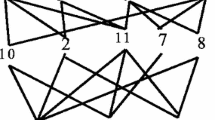Abstract
A concept hierarchy is a kind of general form of knowledge representation. Most of the previous researches on describing the concept hierarchy use tree-like crisp taxonomy. However, concept description is generally vague for human knowledge; crisp concept description usually cannot represent human knowledge actually and effectively. In this paper, the fuzzy characteristics of human knowledge are studied and employed to represent concepts and hierarchical relationships among the concepts. An agglomerative clustering scheme is proposed to learn hierarchical fuzzy concepts from databases. Further, a novel measurement approach is developed for evaluating the effectiveness of the generated fuzzy concept hierarchy. The experimental results show that the proposed method demonstrates the capability of accurate conceptualization in comparison with previous researches.



Similar content being viewed by others
References
Blake, C., Keogh E., & Merz, C. J. (1998). UCI repository of machine learning database, Irvine, University of California, Department of Information and Computer Science, from http://www.ics.uci.edu/~mlearn/MLRepository.html.
Burmeister, P. (1996). Formal Concept analysis with ConImp: Introduction to Basic Features, TU Darmstdt, Germany, Technical Report, from http://www.mathematik.tudarmstadt.de/˜burmeister/.
Chien, B. C., & Liao, S. Y. (2003). Mining categorical concept hierarchies in large databases. Proceedings of 7th World Multiconference on Systemics, Cybernetics and Informatics, 2, 244–249.
Fisher, D. H. (1987). Knowledge acquisition via incremental conceptual clustering. Machine Learning, 2(2), 139–172.
Gennari, J. H., Langley, P., & Fisher, D. (1989). Models of incremental concept formation. Artificial Intelligence, 40(1), 11–61.
Han, J., & Kamber, M. (2001). Data mining: Concept and techniques. Morgan Kaufmann.
Klir, G. J., & Yuan, B. (1995). Fuzzy sets and fuzzy logic: Theory and applications, Prentice Hall.
Mangasarian, L., & Wolberg, W. H. (1990). Cancer diagnosis via linear programming. SIAM News, 23(5), 1–18.
Mitchell, T. M. (1997). Machine learning. McGraw-Hill.
Quinlan, J. R. (1986). Induction of decision trees. Machine Learning, 1(1), 81–106.
Talavera, L., & Bejar, J. (2001). Generality-based conceptual clustering with probabilistic concepts. IEEE Transactions on Pattern Analysis and Machine Intelligence, 23(2), 196–206.
Acknowledgments
This work was supported in part by the National Science Council under Grant NSC95-2221-E-024-014
Author information
Authors and Affiliations
Corresponding author
Rights and permissions
About this article
Cite this article
Chien, BC., Hu, CH. & Ju, MY. Learning fuzzy concept hierarchy and measurement with node labeling. Inf Syst Front 11, 551–559 (2009). https://doi.org/10.1007/s10796-008-9126-z
Published:
Issue Date:
DOI: https://doi.org/10.1007/s10796-008-9126-z




